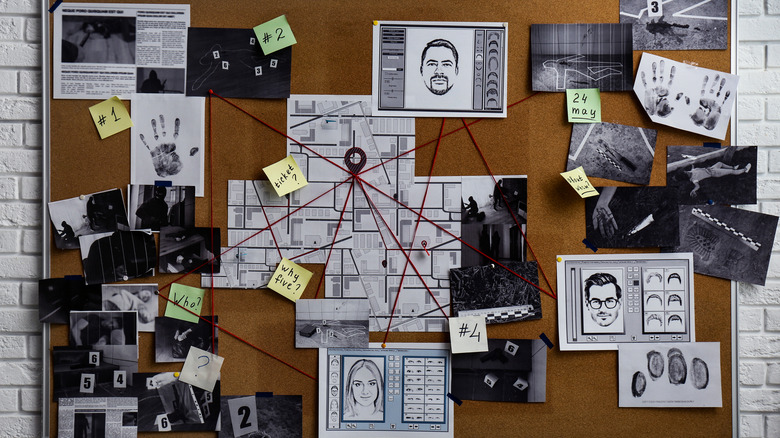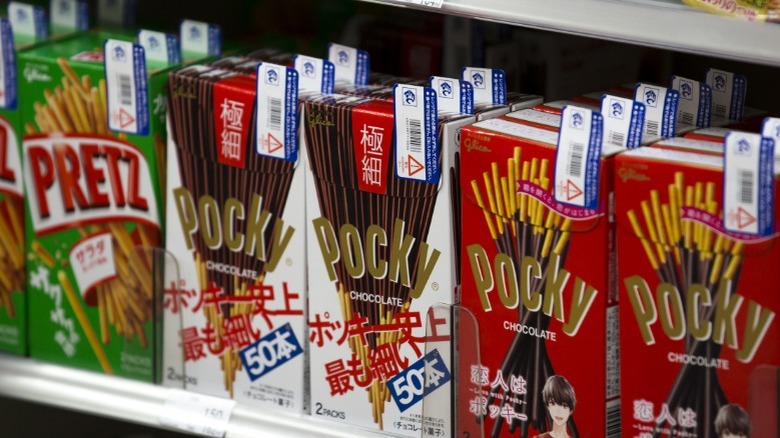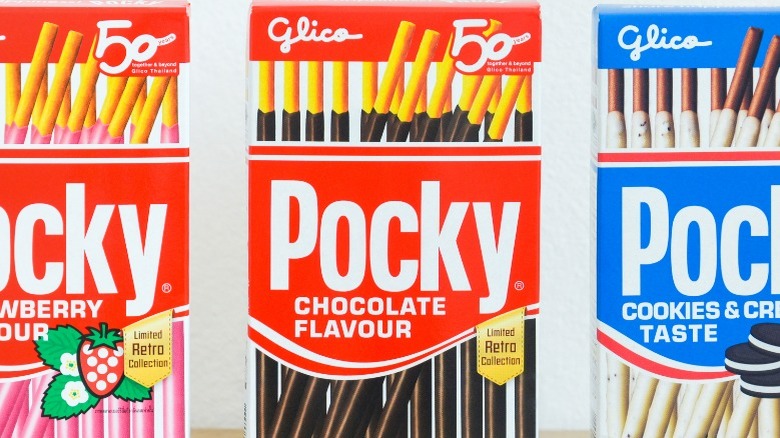The Chilling Kidnapping Case Of Glico Morinaga
Japan has long been regarded as one of the safest countries in the world. This nation has a storied reputation for having low violent crime rates, especially when compared to its Western counterparts (per Japan Today). Despite statistics that continually support Japan's reputation for peace (per Macrotrends), one high-profile kidnapping case in the mid-1980s sent the island nation into a near-tailspin. What began as a kidnapping-for-ransom incident eventually grew into a complicated extortion scheme that caused panic and cost jobs.
The case involved two Japanese candy manufacturing giants, Glico and Morinaga. For nearly a year and a half, corporate executives, the police, and the media received letters threatening drastic actions if certain demands were not met. The Glico-Morinaga case is probably one of the most unusual extortion cases in criminal history. Aside from a group of unidentified individuals attempting to score large sums of money from big business, it involved a high-profile kidnapping, poisoned candies placed on grocery store shelves, and the suicide of a police superintendent.
The bizarre case began with the kidnapping of a candy company executive
This one-of-a-kind case was set in motion by the kidnapping of one of Japan's top corporate executives. Katsuhisa Ezaki, who was serving as president of Ezaki Glico Co., was abducted by masked intruders one evening. The 42-year-old candy executive was taking a bath when the two men interrupted his evening soak (per The New York Times). Just moments before, they accosted Ezaki's mother, armed with a pistol and an air rifle. The elderly woman lived next door to Ezaki, and the men broke into her home and forced her to turn over her son's house key to them (via UPI).
The New York Times reports that the men tied up Ezaki's wife and one of their children before making their way upstairs. They forced an alarmed Ezaki out of the bath and marched him naked out to their getaway vehicle. Police were able to get a brief description of the red car that drove away that evening. In the nearby city of Osaka, a ransom note was soon discovered inside a phone booth. The kidnappers demanded the U.S. equivalent of more than $4 million in cash and a large amount of gold bullion in exchange for Ezaki's safe return. Part of the ransom note read, "Don't inform the police. The hostage will be returned if you pay."
Several days later, Ezaki was able to escape his confinement in the warehouse that he was forced to stay in. The men left him unattended for a time, allowing him to find a way out and to safety (via UPI).
The nightmare was only beginning for Glico
Now that the president of Glico was safely home, it would have been the perfect time to move on. But the kidnappers were only getting started with their terrorist attacks on the company. A month after the company president was nabbed, the group behind the crime shifted gears and began to target Glico employees. Historic Mysteries reports of how several vehicles owned by the candy manufacturer's staff were set ablaze on April 10, 1984. But the biggest threats came in May when the group put the candy-eating public at serious risk.
On May 10, the company received a letter stating that the sender had poisoned packages of Glico candies with potassium cyanide. According to All That's Interesting, it was signed by "The Monster with 21 Faces," believed to be a reference to the 1963 novel "The Fiend with the Twenty Faces." Whether or not what the letter purported was true or not, action needed to be taken. When the contents of the letter were made public, stores all over Japan couldn't clear Glico candies off of their shelves fast enough. The company would go on to recall packages that had already been shipped and stocked, resulting in catastrophic financial losses for Glico.
The New York Times reports that Glico's sales numbers were half of what they were the year before, comparing May 1983 to May 1984. The $130 million loss that Glico suffered cost an estimated 1,000 workers their livelihoods as the company was forced to downsize staff with massive layoffs.
The tormentors soon pulled back
The fear of what might come next was probably on the minds of Glico's employees and investigators. Would it be another kidnapping? More arson? Or would someone die this time from poisoned treats that were put on the grocery store shelves? More taunts and letters did arrive, but their contents probably weren't what the company was expecting.
The letters that were coming in now claimed that the perpetrators were becoming "bored with this affair" and were moving on. That letter noted that the 15 boxes of cyanide-laced Glico candy that they were planning on putting in grocery stores had been burned (via The New York Times). In a final, taunting letter, "The Monster with 21 Faces" wrote that their "colleagues include a 4-year-old child who every day wants to eat Glico products. We can't have this child crying all day," giving a reason to abandon their campaign. The ongoing police investigation never did yield any arrests, and to this day, no one can be 100% certain who was behind the campaign to derail the candy manufacturer. For Glico, the nightmare was over. But for a rival candy company, it was just beginning.
A second candy company is targeted
In October 1984, Japanese media received a letter that was addressed to the "Moms of the Nation." Historic Mysteries tells of how the letter gave details on how the sender had laced 20 packages of candy made by the Morinaga candy company with poison. The cyanide-tainted treats were said to have been sealed back in the company's original packaging and placed on shelves of grocery stores in Japan.
An exhaustive search was conducted, and police discovered a new twist from the Glico threats. This time, they found nearly two dozen packages of candy with stickers affixed to them that read "Danger: Contains Toxins" (per Japan Talk). The sender pointed out that the candy packages they needed to look for had this handy warning, but they indicated that the next batch would leave the consumers on their own. The letter threatened that more poisoned boxes of candy would be placed in stores unless their demands were met. In a final taunt, the letter closed with the words (per The New York Times), "Morinaga is the best when it comes to confectionery." However, they continued, the candies ”now taste a bit bitter since we have added a special seasoning of sodium cyanide." It was signed "Kaijin 21- Menso," or "The Monster with 21 Faces."
The letters that Moringa received soon after outlined the sender's demands. Unless the company wanted poisoned products on the store shelves, they would need to pay the U.S. equivalent of $410,000 (per The New York Times).
A frustrated officer dies by suicide
The terrorists gave instructions on how to deliver the money to them. An officer was to take the money, board a specific Kyoto train, and wait for a white flag. The officer did as instructed but never saw the signal. He did notice a man on the train behaving oddly and began to surveil him (via Historic Mysteries). He noted that the man was well-built and had "eyes like a fox." This money drop would end up being a bust, as would the second attempt. No other poisoned candies appeared on the shelves, but those involved with the case were probably on pins and needles expecting the worst.
The crimes only resulted in one casualty. Crime Reads reports how a frustrated police superintendent died by suicide after he could not secure even a single arrest in the case. The defeated man went into his backyard, poured kerosene all over himself, and set himself ablaze. After news of his death was public, the culprits sent one last letter. It read, "So we decided to give our condolence. We decided to forget about torturing food-making companies. We are bad guys. That means we've got more to do other than bullying companies." With that, the Monster with 21 Faces was never heard from again.
But even if the culprits are identified, there would not be any legal repercussions for them at this point. Historic Mysteries points out that the statute of limitations for both poisoning consumer products and kidnapping has long since passed. The police have officially closed the case.
If you or anyone you know is having suicidal thoughts, please call the National Suicide Prevention Lifeline by dialing 988 or by calling 1-800-273-TALK (8255).





